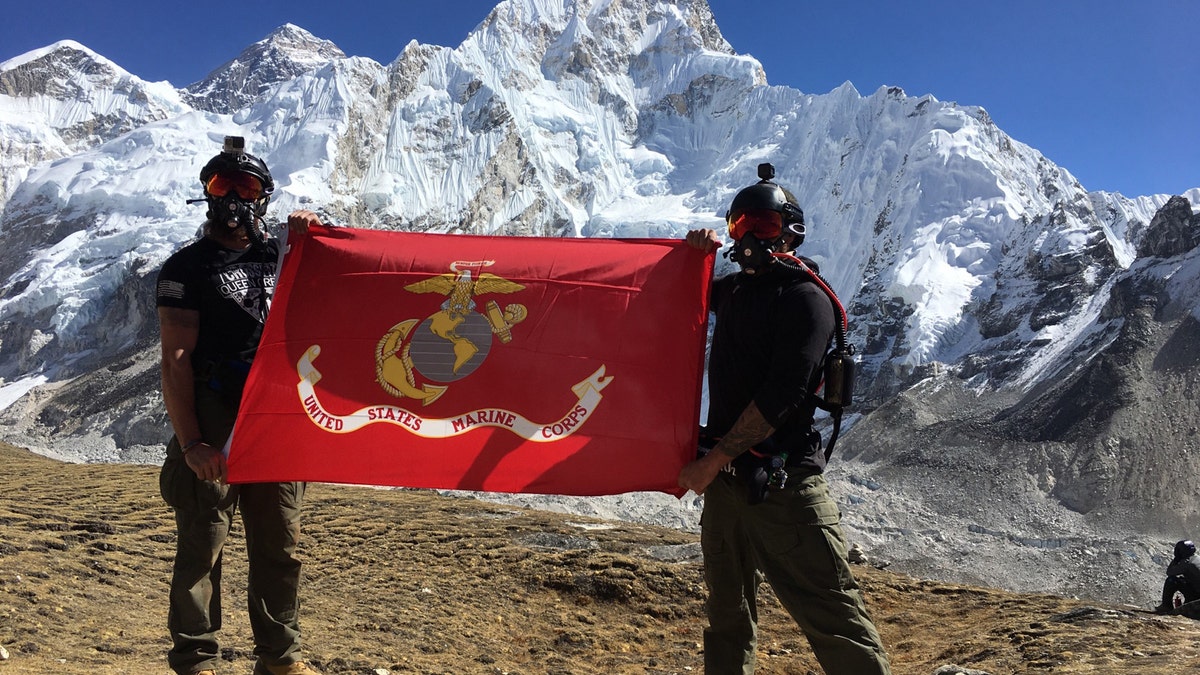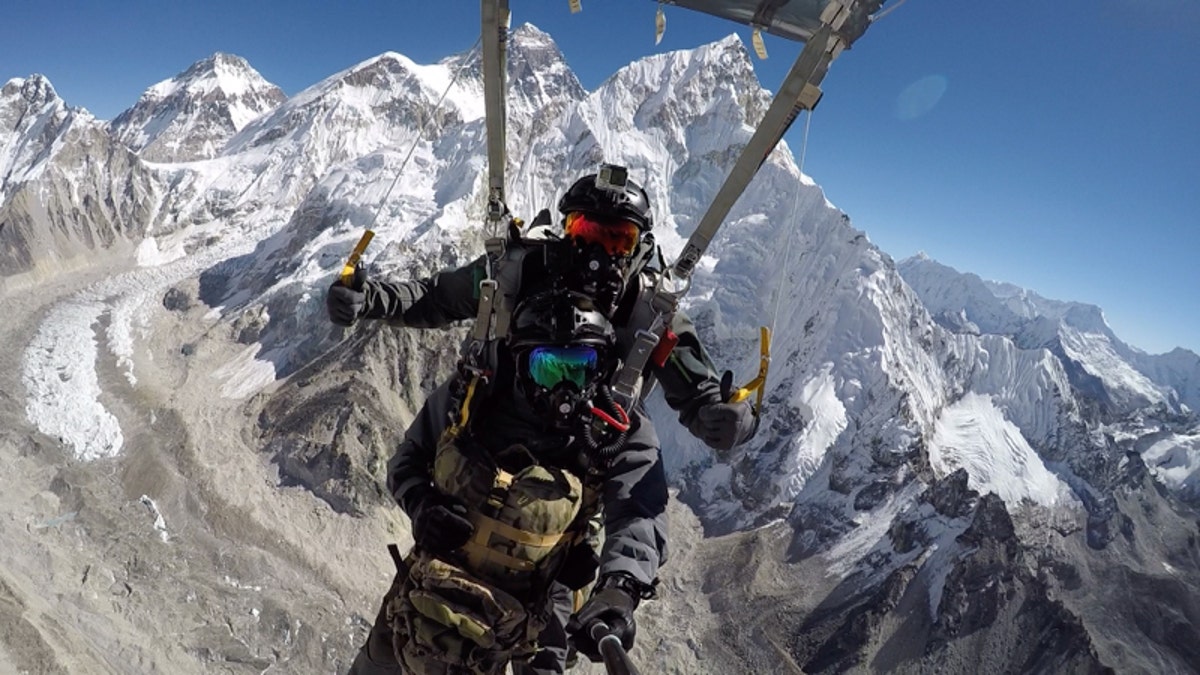
(Complete Parachute Solutions).
A team of brave U.S. military veterans headed into the Himalayas armed with skill, one helicopter and a whole lot of state-of-the-art gear last month – and left the mountains with four skydiving world records.
Military Free Fall, or MFF, is a way for forces to insert military personnel, gear and even canines. Military parachutists jump from a fixed wing aircraft or a helicopter at high altitudes, then then use a parachute to travel through the air to land at a pre-determined location.
This expedition aimed to push the limits for military free fall and make the seemingly impossible possible. The team headed deep into the Everest region of the Himalayas to attempt landings on some of the highest mountains in the world. Complete Parachute Solutions (CPS) provided parachutes for the expedition.
Putting that in context, the highest airport in the United States is at Leadville, Colorado, at 9,334 feet elevation. The first series of expedition jumps were at Syangboche, Nepal, at about 12,400 feet.
Former Navy SEAL and CPS CEO Fred Williams handpicked his team for the extreme, unique environment. His goal was to assemble the most experienced team possible - from parachutists and Sherpa guides through to oxygen experts, emergency medicine and a helicopter pilot.
EXCLUSIVE: INSIDE AN EPIC PARACHUTE JUMPING EXPEDITION IN THE HIMALAYAS
In addition to William’s SEAL experience, team members had served in the U.S. Marine Corps Force Recon, Raiders and top sniper cadre as well as an MFF expert who served in the Army and an expert British oxygeneer who served in the Royal Air Force. The team also included extremely accomplished civilian parachutists who also brought special skills like exceptional medical experience.
The team smashed not just one world record – but four world records, according to CPS.
Defeating Dangerous Conditions
To succeed, they needed to overcome formidable winds, extreme cold and the lack of oxygen at high altitudes.
To overcome hypoxia, or oxygen deprivation, the team relied on the next-gen Multi-purpose Tactical Oxygen System (MTOS) from TopOut Aero.

(Complete Parachute Solutions).
With the highest of stakes, jumpers had to land on tiny impromptu landing zones created on some of the highest mountains in the world. Failing to nail the landing could mean death. Some of the designated landing zones were awkward tiny mountainside perches surrounded by sheer drop offs.
To make successful landings on these extremely difficult spots, the team relied on the CPS parachutes used by American, and allied, special operations units around the world.
The Adventure
The team assembled in Dubai, United Arab Emirates and then flew on to Kathmandu, the capital of Nepal at an elevation of about 4,500 feet to begin acclimatizing their bodies to high altitude and lack of oxygen. They then travelled to Lukla, notorious as the most dangerous airport in the world, then climbed to 12,400 feet at Syangboche airport to conduct initial parachute operations.
SPECIAL FORCES' PARACHUTES: WHAT YOU NEED TO KNOW
In the mountains, the team tackled rocky trails and obscure paths with steep inclines and rapid descents. While moving up the mountains, the Himalayan mountain range provided a spectacular backdrop with the snow-capped peaks of Mount Everest and some of the other highest mountains of the world filling the skyline.
First World Record
Magpul CORE instructor and extremely accomplished Marine Corps sniper veteran Caylen Wojcik arrived in the Himalayas with the fewest jumps on the team- a mere 50. Yet he broke records, becoming the parachutist with the least amount of jumps to successfully land at 12,500 feet after an aggressive mission-specific training program.
After completing parachute operations at Syangboche, the team divided into two units.
One unit became the advance team tasked with recon, prep work for the landing zones and testing the MTOS capabilities to the max. They raced up the mountain in advance of the jumpers, navigating both the steep Himalayan inclines and tough terrain with the speed required of special operations work.
This team was primarily comprised of extremely accomplished and experienced former Marine Corps operators. They now work for Magpul where the company harnesses their expertise for Magpul CORE, a training division for military personnel and civilians that hones skills in areas such as firearms manipulation, fieldcraft and hunting.
DARPA DEVELOPS DIGITAL COPILOT FOR MILITARY AIRCRAFT
The second team focused on the jumping.
The advance team climbed and trekked to Ama Dablam where the second team joined them by helicopter for a series of jumps landing at approximately 15,000 feet – about 6,000 feet higher than the highest established drop zone in the United States.
Second World Record
U.S. Marine Corps Captain Cody Caroll now serves in the reserves and achieved the team’s first world record. At Ama Dablam, he accomplished the highest combat equipment parachute landing ever achieved by a U.S. Marine. He carried an oxygen system plus a 70-pound rucksack.
And even more remarkably, Carroll only had about 150 jumps under his belt he achieved the Marine Corps record.
Next, the teams zeroed in on Gorak Shep Lake Bed. They climbed to Gorak Shep at 16,942 feet and then onto Kala Phatter at 17,500 feet.
Tandem World Records
It was at Gorak Shep, Marty Rhett and Hunter Williams set the team’s first tandem record.
Using the CPS TP460 parachute and carrying oxygen systems plus two rucksacks, Rhett and Williams accomplished the highest tandem combat equipment parachute landing in history at a remarkable 16,850 feet elevation.
A NEW COMBAT VEHICLE THAT SWIMS FOR THE MARINE CORPS
To put this in context, they landed about 2,500 feet higher than the tallest peak in the continental United States.
At Gorak Shep, civilian skydiving instructor Tom Noonan and British armed forces veteran Ted Atkins also set the highest tandem parachute landing world record jumping with the CPS Special Operation Vector 3 Tandem Sigma.
You can meet the team and immerse yourself in the adventure at Tactical Talk available on iTunes. Host Allison Barrie brings listeners with her on the expedition from kick off in Kathmandu through to the Himalayan mountains, flying around in the helo, hanging out at the base camps and breaking world records with the extreme jumps.




















